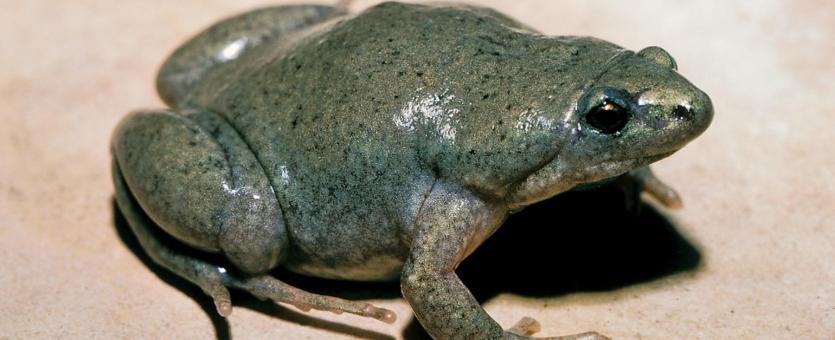
The western narrow-mouthed toad has a plump body, short legs, uniform color, small, pointed head, and a fold of skin across the back of the head. The general color is gray, tan, or olive tan. Small black spots may be scattered over the back and hind legs. There is no webbing between the toes. The belly is white, though breeding males have dark throats.
The call of a male western narrow-mouthed toad is a high-pitched, short “peep” followed by a nasal buzzy bleat, which lasts 1–4 seconds. The sound is similar to a buzzing bee.
Similar species: The eastern narrow-mouthed toad, a close relative, has a darker overall color as well as a pattern of dark markings on the back. Also, its call is a bleating, nasal baaaa, like the cry of a lamb, and is nothing like the call of the western narrow-mouthed toad. Missouri's two narrow-mouthed toads have different distributions in the state, but the ranges do overlap in several western counties. In these counties, populations may occur in the same area. However, the calls of both species are different enough to prevent them from hybridizing.
Adult length (snout to vent): 1 to 1½ inches; occasionally to about 1¾ inches. Females are larger than males.

Reported from far western and northwestern Missouri and east along the Missouri River floodplain as far as the center of the state (Boone and Callaway counties). Missouri represents the eastern extent of this Great Plains species' range.
Habitat and Conservation
This species prefers grasslands, rocky and wooded hills, and areas along the edge of marshes. In Holt County, researchers observed individuals on southwest-facing slopes of the loess hills characteristic of that region.
These toads are mainly active on the surface from April into October. They are are very secretive and spend most of their time hiding in loose soil and under rocks, logs, or other objects; they have been known to take shelter in animal burrows, especially tarantula burrows. In central Texas, they have been observed sharing a burrow with eastern collared lizards.
Food
Mostly ants. They occasionally eat small beetles, too. Western narrow-mouthed toads have evolved a toxic skin secretion that protects them from ant bites. They typically sit on anthills while eating their preferred food.
Status
This species used to be called the Great Plains narrow-mouthed toad.
Life Cycle
In Missouri, breeding primarily takes place from May to early July but can also occur later in the summer after warm, heavy rains. The usual breeding sites are ditches, temporary ponds, flooded fields, or pools in wooded areas. Warm, heavy rains stimulate males to congregate at breeding sites and begin calling. Males call from thick vegetative cover along wetland margins or while floating among vegetation in shallow water. Special skin glands on the male’s belly secrete a gluey substance that sticks the mating pair together. The female lays 500–1,000 eggs (or more) as a film on the water surface. As with the eastern narrow-mouthed toad, the membranes enveloping the eggs can have flat sides, making the film of eggs look like a mosaic. The eggs hatch in 2–3 days, and the tadpoles transform into froglets 20–30 days later. They become sexually mature in 1 or 2 years.
Human Connections
As predators, these amphibians help control populations of many insects that are pests to humans. Additionally, their weirdly beautiful, strange-sounding choruses add to the magic of a Missouri evening.
The genus name, Gastrophryne, means "stomach-toad." It's a great name for these pudgy-looking animals.
Ecosystem Connections
Narrow-mouthed toads are predators that help keep populations of ants and other insects in balance.
They, and especially their eggs, tadpoles, and young toadlets, become food for both aquatic and terrestrial predators, including larger frogs and snakes. Predators of the species, however, are not well-known. There is at least one record of a copperhead snake eating a western narrow-mouthed toad in Jackson County.
These toads share burrows with tarantulas, lizards, moles, and perhaps other animals. The relationship with tarantulas appears to be mutualistic, as the tarantulas allow the toads the living space, and offer protection from predators, and the toads eat up any ants that might otherwise invade the tarantula's nest.
The narrow-mouthed toads (Microhylidae) are a large family of burrowing, secretive frogs. The family has representatives in Asia, Malaysia, northern Australia, New Guinea, southern Africa, Madagascar, and North and South America. The group probably originated in Asia. The family contains 63 genera with 557 species. In the United States, this group is represented by two genera and four species; of these, two species of one genus (Gastrophryne) live in Missouri. Most members of this group are fossorial (burrowing), spending most of their time in burrows or under rocks or logs. They tend to be small, plump, and squatty in appearance. All species in the United States have a characteristic fold of skin behind a small, narrow, pointed head. Although they may eat many types of small insects, these amphibians are mostly ant eaters.



























